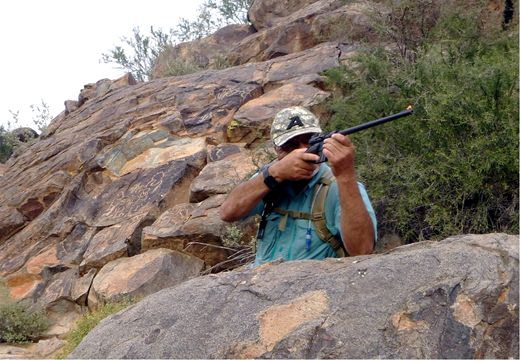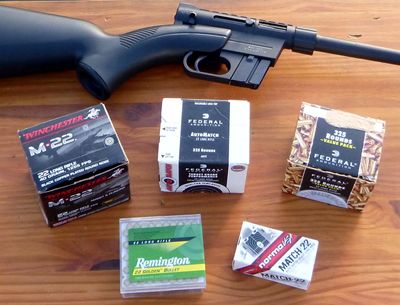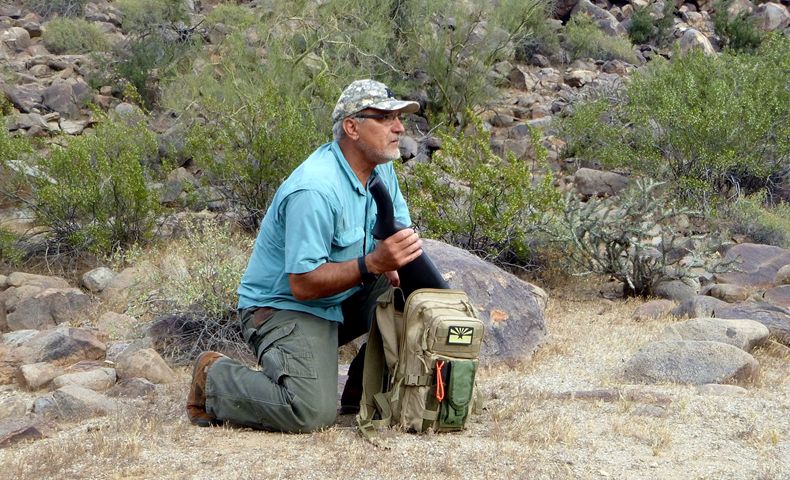I would never call myself a prepper or a survivalist, but nevertheless I have
taken a few precautions to prepare for adverse circumstances. I think that a
lot of us gun guys have at least a little of that basic mentality that we must
be ready for the moment when things go all haywire.
At home I have laid in a fair inventory of MRE meals (with the help of one of
my sons). I have a bank of large batteries in the garage, about 10
kilowatt-hours in total, that I can use to power the fridge or freezer for at
least a couple of days in the case of a power outage. Then there are the solar
panels on my camping trailer that I can put to work if the power should stay off
longer.
As a backcountry geocacher, I try to pack at least the first five of Dave
Canterbury’s “10 C’s of Survivability” in my pack at all times. I am usually
solo in the backcountry, sometimes on four wheels, sometimes on dirt bike,
sometimes on foot. I have definitely had things go wrong for me in all of those
circumstances. Thankfully, or maybe wit-fully, I have so far always been able to
get myself out of trouble without having to spend an unplanned night in the wild.
As a kid I grew up reading Outdoor Life magazine. One of the ongoing features in
Outdoor Life was
“This Happened to Me”. It was a feature sort of in the form of comic book
stories, with drawn illustrations, that told harrowing tales of outdoorsmen in bad
situations. As a wide-eyed young lad, I soaked up those stories and tried to learn
lessons from each one.
That introduction was just my way of putting readers into the mindset to think about
why having a go-everywhere, lightweight, takedown .22 rifle could be a good idea.
Imagine yourself with your AR-7, stuck deep in the backcountry: You are surrounded
by a fearsome pack of wolves; or maybe you just need to bag a bunny or squirrel for
dinner. Sure – nothing more than a fun fantasy. Fun, as long as it is not really
happening to you.
After being around for 57 years, most folks know at least something about the AR-7,
but allow me to briefly recap. The AR-7 Explorer was introduced to the market by
Armalite in 1960. Yes, the same Armalite, the same Gene Stoner, that gave us the
AR-10 and the AR-15.
The AR-7 was a follow-on to the AR-5, which was a bolt action .22 Hornet that was
designed to satisfy the Air Force’s requirements for a pilot’s survival rifle. The
AR-7, a .22LR semiautomatic, was not designed for military contracts however. From
the beginning it was designed to sell to the general public as a means of generating
some income for the company because government uptake of the AR-10 and AR-15 designs
was slow in coming.
What sets the AR-7 apart from all other semiauto .22’s is that it is designed to
separate easily, without tools, into 4 components: the buttstock, the receiver, the
barrel, and the magazine. There is a plastic cap that forms the recoil pad of the
buttstock that easily removes and allows the barrel, receiver, and magazine to all
store inside the hollow stock. That allows the entire gun to takedown into one 16”
long package that is only the size of the buttstock. This will easily fit in most
backpacks. And since the whole rifle weighs only about 3½ pounds, it is hardly a
burden to take along with you anywhere.
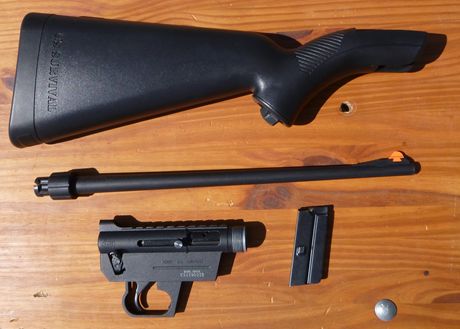
|
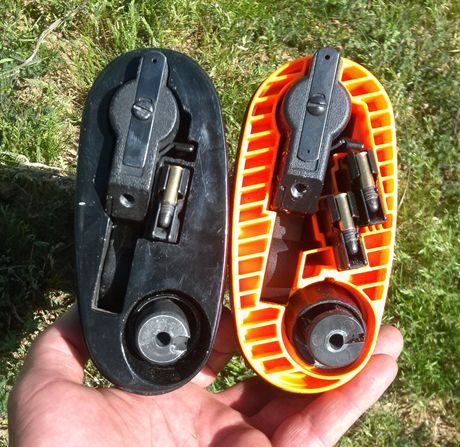
Charter Arms AR-7 on the left, Henry U.S. Survival Rifle on
the right. Henry redesigned the stock to hold two magazines,
plus one in the receiver for a total of 24 rounds. The Charter
Arms AR-7 can only pack one magazine with 8 rounds.
|
I don’t have an original Armalite AR-7, but I do have one made by Charter Arms.
Armalite sold the manufacturing rights to Charter Arms in 1973. Charter Arms
continued to produce the AR-7 through 1990. They then sold the design to Survival
Arms, then later it went to AR-7 Industries. As you can see, AR-7 production over
the years has had somewhat of a checkered past. The Charter Arms AR-7s in particular,
had a reputation for reliability problems and overall spotty quality.
The Charter Arms AR-7 came to me when my Dad passed. I didn’t even know that he owned
one. Yes it had problems when I got it. If I recall correctly, it would not eject
after firing. I ended up trading it away to Dale Saverud as part of a package deal
that included a muzzleloader. Several years later the rifle came back to me. Dale
had replaced some part and it was now working.
Sometimes I carried it in my pack on my backcountry excursions, but really not very
much. It did come along with me on just about every camping trip though. It was
always great fun to break it out and pop away at empty cans when not much else was
going on around camp. So in all honesty, the gun’s main role in our family has been
as a fun camp gun.
Earlier this year, I was on a campout with friend-from-work, Wu. He had a general
season javelina tag, I was still recovering from shoulder surgery so I did not apply
for a tag. But I had a fever to take my camping trailer out. I had not been camping
since the summer, and I felt that my shoulder had healed up enough to handle a campout.
But when I pulled the AR-7 out of the camp box, I found that I could not pull the bolt
back. I tried to take it apart at camp, and of course some small spring came flying
out, hit me in the forehead, and was never found again.
When I got home and could examine the gun in more controlled conditions, I figured out
what was wrong, and what parts I needed to replace. There is an outfit called AR-7
Customized Accessories (AR-7.com)
that has all the parts available, at a very reasonable cost. A quick web order had the
parts to me in a very short time, and I had my AR-7 back to running again, sort of.
After taking it out to test my repairs, I found that I was now suffering from light rim
strikes (wouldn’t fire) and iffy extraction once again.
The new failures, plus the January edition of American Rifleman, got me interested in
purchasing a new AR-7. There was a very comprehensive story of the history of the
AR-7 in that edition, plus a review of the currently manufactured Henry Repeating Arms
U.S. Survival Rifle.
From what I gathered from the article, Henry did not purchase the manufacturing rights
for the AR-7 from anyone. Since the patents had run out, they just reverse engineered
it. And while doing so, they altered and improved the original design in a couple of
small, but useful ways.
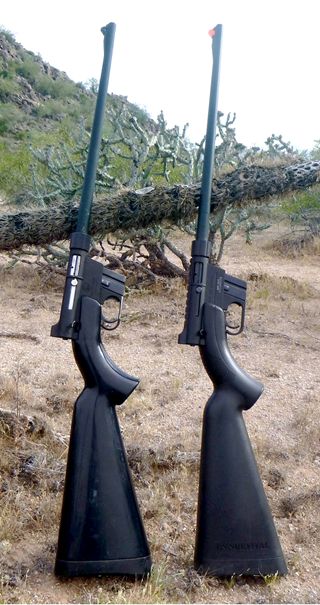
Charter Arms AR-7, left;
Henry U.S. Survival Rifle, right.
|
First, the buttstock was redesigned so that the receiver would fit in the stock with a
magazine in place. The original Armalite design that the Charter also followed, would
not allow the receiver to go in if a magazine was installed.
Second, the Henry buttstock allows the storage of two magazines instead of just one.
So now the new survival rifle in your pack becomes a lot more useful since you now can
carry 24 rounds instead of just 8.
Third, the top of the Henry’s receiver has been modified with a pseudo-Picatinny rail
machined into its top surface. It’s actually a 3/8” wide .22 groove rail, but with
multiple cross slots which makes it look like a mil-spec Picatinny rail at first glance.
Of course if you mount an optic on the rail, you can no longer pack the receiver inside
the buttstock.
The plastic buttstocks of the original Armalite and Charter Arms AR-7s were filled with
styrofoam in the spaces where barrel, receiver and magazine didn’t need to go. This
helped them float. Floatability was an Air Force requirement for the AR-5 that was
carried over to the AR-7. The Henry uses an orange plastic piece inserted into the back
of the buttstock that locates the gun’s stored components, but there is no styrofoam.
Given enough immersion time, enough water will seep into the Henry’s stock and allow it
to sink – eventually.
One problem that I’ve had with the Charter is if you are walking through the woods with
the gun in the assembled state on the lookout for game, you suffer the chance of losing
the plastic buttcap. It fits kind of loosely. The Henry’s is tighter. Now that may be
just because it is new, but it seems to be made of a better plastic.
On the other hand, the component recesses in the Charter stock are made with retention
features molded into the plastic. The parts will not simply fall out if the buttcap is
removed and the stock is held pointing skyward. The Henry does not seem to have any part
retention features. The stuff will fall out so you need to be more careful.
The older AR-7’s stocks were made of a smooth and shiny plastic. The Henry has a matte
textured surface and grooves are molded into the top of the wrist of the stock for better
grip-ability.
Overall the Henry seems a bit heavier than the Charter Arms AR-7. The American Rifleman
article puts it at about a half pound more. The article says that the extra weight is
mainly due to a thicker receiver casting.
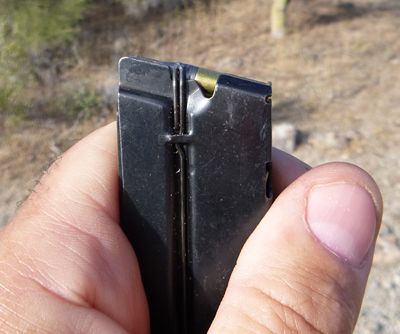
Wire added to side of Henry magazine
|
Another difference is that the Armalite and Charter barrels were made of aluminum with
a steel bore liner. The Henry barrels substitute a modern high-strength polymer in
place of the original aluminum.
Henry also made a change to the magazines. They added a doubled-over wire to the side
of the magazine that curls over the nose of the bullet on top. I guess that they found
that this wire aids reliability. As a result, Henry magazines will not insert into my
Charter, though the Charter magazine seems to work just fine in the Henry.
You should not expect fine accuracy out of these rifles. Both have long hard triggers
that release with a lot of fury. I tested for accuracy at 28 yards using the standard
peep sight at the back and blade front sight. The front sight on the Charter is black
steel and is a bit thinner than the glowing orange plastic front sight on the Henry.
I preferred the Charter’s front sight.
Unfortunately the Charter’s malfunctions made it impossible to finish up the planned
accuracy test of five different types of .22 ammo, two groups of each through each gun.
I did manage to complete two types of ammo through the Charter, despite numerous squeeze,
click, remove mag, rack action, reload mag, re-rack action – what a pain!
Using 36 grain Federal 325 count Value Pack ammo, and 40 grain Remington Golden Bullet
ammo, I averaged groups in the Charter just over 3 inches for each.
During the Great .22 Ammo Shortage, I had to grab whatever I could find, whenever I found
it. So I ended up having a wider variety of .22 ammo on hand than I normally would. That
was a great plus for testing purposes.
Even through the Henry, the Federal 325 Value Pack ammo with a 36 grain hollow point, would
not reliably cycle the action. In fact 7 of 10 shots failed to autoload. Nevertheless
groups from this ammo were actually pretty good with an average of the two groups fired of
1.35”.
The Remington Golden Bullets and the Winchester M22 did OK as well, turning in average
groups of 1.65” and 1.53” respectively.
Groups using the Federal Automatch ammo opened up quite a bit more. The groups averaged
3.48”. I also had one failure to cycle out of these 10 shots. This was the Henry’s least
favorite ammo.
I had a very interesting group using the Norma USA Match .22 ammo. Shown to the right,
this group measured only .49”. It could be just a fluke, but it sure was nice to see.
The other group fired with this ammo was more ordinary at 2.3”, bringing the average to
1.4” for the pair of groups.
The Henry was pretty inexpensive, just a little over $260 out the door. The rifle comes
with two magazines. If you want a third, because that’s how many a packed rifle will hold,
Henry only sells extras in a two-pack for $40.
Now that I know where to get parts, I will try again to get the Charter Arms AR-7 running
like it is supposed to. I think that the light rim strike problem is nothing more than an
old firing pin that has been dry fired too many times over the years.
And I’m hoping that a new extractor will once again take care of the failures to extract.
After Dale replaced the extractor the last time, the Charter actually ran pretty well for a
long time, many years.
I really love the concept of a packable rifle that goes un-noticed while you don’t need it,
but it’s ready-to-go when you do. Now that I have the Henry, my appreciation for the AR-7
has been renewed. Sure it’s got a funky fat stock, and the action sits off-center in that
stock. That’s what makes it possible to take down and store away as it does. I just think
it’s fun and cool.

![]()

